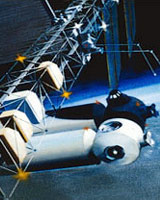UNESCO project on scientific cooperation in South-East Europe continues to expand
11-02-2008 (Paris)

Photo from the Thales Alenia
Space website
© Thales Alenia Space
An expert meeting with the goal to attract the interest of specialised institutions to UNESCO's Space for Science project took place on 31 January 2008 at UNESCO Headquarters. Organized by UNESCO, in cooperation with the World Academy of Biomedical Technologies (WABT), the meeting brought together participants from international organizations, in particular the European Space Agency and the CARDS programme of the European Commission.
Space for Science project was born as a follow-up of different expert and ministerial meetings initiated by UNESCO in 2001 and 2002 and related to the reconstruction of scientific cooperation in South-East Europe (SEE). It was unanimously stated that a high performance network would be a key tool for strengthening Research and Development in this region and for facilitating the integration of SEE countries into a pan-European scientific network. In this context, UNESCO approached the European Space Agency (ESA) for applying satellites technologies to provide research and higher education institutions in SEE with access to scientific content and services.
It resulted in the Space for Science project, which aims to facilitate scientific and technical cooperation in South-East Europe by providing virtual, collaborative and education services to academic and higher education institutions through fast academic networks and two-way satellite channels. The project is supported by ESA and an industrial consortium specifically set-up by ESA for this purpose.
In 2006, the first stage of the Space for Science involved 18 SEE research and higher education institutions. Both technical and operational solutions were reviewed. Alcatel-Alenia Space (incorporated, since 2006, in Thales Alenia Space), C2Consultants, IBM and UNESCO all joined together within a consortium for the project. Two-way satellite services were deployed over 18 SEE research and higher education institutions from the scientific fields recommended by the Ministerial Round Table held at UNESCO in 2001.
The expert meeting that took place last January aimed at pursuing the project in a specific scientific field. NGOs, scientific organizations and private companies specialised in telemedicine and e-health scientific research, space applications, economics and development participated in the discussion. Their goal was to attract the interest of specialised institutions in order to cooperate in further extension of the Space for Science. They discussed ideas for such cooperation and explored new possibilities for funding.
It resulted in the Space for Science project, which aims to facilitate scientific and technical cooperation in South-East Europe by providing virtual, collaborative and education services to academic and higher education institutions through fast academic networks and two-way satellite channels. The project is supported by ESA and an industrial consortium specifically set-up by ESA for this purpose.
In 2006, the first stage of the Space for Science involved 18 SEE research and higher education institutions. Both technical and operational solutions were reviewed. Alcatel-Alenia Space (incorporated, since 2006, in Thales Alenia Space), C2Consultants, IBM and UNESCO all joined together within a consortium for the project. Two-way satellite services were deployed over 18 SEE research and higher education institutions from the scientific fields recommended by the Ministerial Round Table held at UNESCO in 2001.
The expert meeting that took place last January aimed at pursuing the project in a specific scientific field. NGOs, scientific organizations and private companies specialised in telemedicine and e-health scientific research, space applications, economics and development participated in the discussion. Their goal was to attract the interest of specialised institutions in order to cooperate in further extension of the Space for Science. They discussed ideas for such cooperation and explored new possibilities for funding.
Related themes/countries
· Private Sector Partnerships
Share this story:
Contact information
- UNESCO
Source














